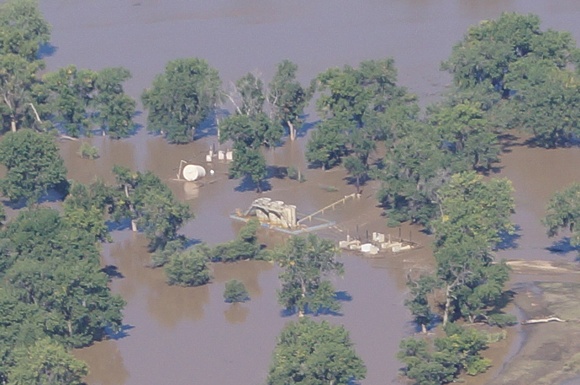We have much more to do and your continued support is needed now more than ever.
UPDATED:Flood of `Biblical Proportions’ Leaves Behind Devastation, Pollution

Then there’s the trouble we’re just starting to glimpse. The flood waters carried by swollen rivers and creeks along Colorado’s Front Range are rolling across the eastern plains. Right in the path is Weld County, site of 20,544 active oil and gas wells as of Sept. 5. The Denver Post and other media started reporting about oil and gas spills late Wednesday. Anadarko Petroleum notified state regulators that at least 5,250 gallons from two tank batteries had spilled into the South Platte River. The company is using booms to absorb the oil and says it is using a vacuum in the cleanup.
As of Friday, regulators had confirmed spills totaling about 22,000 gallons, including 13,500 gallons of condensate — an oil and water mixture — from tanks near the St. Vrain River.
The Denver Post reported that the Colorado Oil and Gas Conservation Commission, which regulates the industry, called five spills along the South Platte “notable.”

What’s in the water?
Industry representatives said earlier this week that nealy 1,900 wells in flooded areas had been shut down and that 600 employees were out inspecting and repairing equipment. Left unexplained was how could anyone know whether any storage tanks and other equipment had been swept away? How many are damaged and leaking? What about waste pits and pipelines?
The immediate attention appropriately has been on rescuing people and minimizing the damage. But the early reports about problems in the state’s largest oil and gas field drive home the fact that Coloradans will be coping with the effects for a long time. And we likely won’t even know the full extent of the effects for a while.
Thousand-year flood
The deluge is being called a 1-in-1,000-years flood. The National Weather Service says all kinds of precipitation records were broken in Boulder, which receives an average of 1.7 inches of rain in September. As of Monday, Boulder’s rainfall totaled 17.17 inches for the month. The area got 9.08 inches in 24 hours, another new record.

Warm air holds more moisture. The downpour that lasted days occurred in one of the area’s driest months. The Boulder-based National Center for Atmopsheric Research, where many climate scientists work, was closed by the flooding. It was closed last summer because of a nearby wildfire.

In Colorado and much of the Southwest, the word in weather is “extreme.” Last summer Colorado experienced record-breaking heat. This year, we’ve seen what would normally be a once-in-a-generation storm. Who knows what’s next?
This version updates the estimated volumes of spills from oil and gas well sites in Colorado’s flood zones.

![]() Speak out on climate change and concerns for affected wildlife, including wolverines! Tell Congress to pass legislation that will preserve habitat for wolverines and other wildlife>>
Speak out on climate change and concerns for affected wildlife, including wolverines! Tell Congress to pass legislation that will preserve habitat for wolverines and other wildlife>>






















